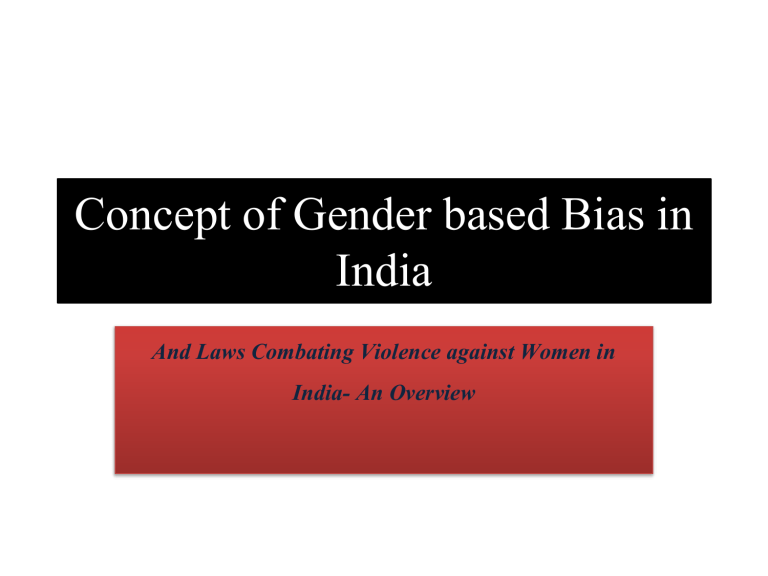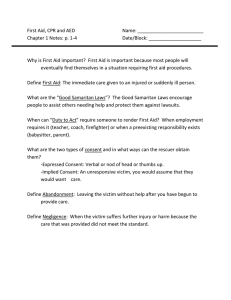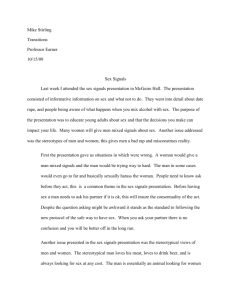
Concept of Gender based Bias in India And Laws Combating Violence against Women in India- An Overview GENDER It’s Meaning and Context • Gender Defined; “the state of being male or female (typically used with reference to social and cultural differences rather than biological ones).” Thus, ‘Gender’ per se is a socio-cultural connotation or a social construction of female and male identity. It includes the ways in which those differences, whether real or perceived, have been valued, used and relied upon to classify women and men and to assign roles and expectations to them. The word ‘gender’ provides for the over-generalizations and stereotypes arising thereof and thus the gender based ‘characteristics’ are followed by the society rather than sex-based characteristics. Difference between Gender and Sex • Gender • Is a socio-cultural connotation. • It is a man-made concept. • Gender differentiates asMASCULINE and FEMININE • A very broad and vague term which may differ from place to place. • Sex • Is a Biological Aspect. • It is an endowed natural and biological aspect of human beings. • Sex differentiates asMALE and FEMALE. • A straight-jacket difference which is usually unchangeable and undeniable. Concept of Gender bias BIASES STEREOTYPES OVERGENERALIZATIONS IDENTITIES BIASES based on Gender arise from the term itself! Gender is categorization on the basis of generalizations and stereotypes. Gender indicating characteristics are so blatant and out on-the-face-of-it that gender-based differences and sex-based differences are often used interchangeably. Gender based norms have now become deeprooted in the society and the society thus relies on these norms and comes out with Masculine and Feminine traits which HAVE to be present in a Man and a Woman, respectively. All such differences have now taken the face of ‘gender inequality’ which is very much in evident in India and much thanks to the patriarchal system, the Gender based biases and prejudices are “generally’’ against the Female section of the Indian society. Gender Based Bias in India 1. 2. 3. 4. Female Feticide Female Infanticide Age of Marriage Procedures for Contracting Marriage 5. Executing Marriages; Customs of Dowry, ‘Stridhan’ 6. Child Bearing 7. Domestic Abuse 8. Divorce 9. Separation 10. Widowhood 11. Remarriage A Suffocating Patriarchal Shadow hangs over the Lives of Women throughout India. Women battling various problems at every stage of their lives. Laws Combating Violence Against Women in India Constitutional Provisions; The Preamble of The Constitution of India provides for Justice, Liberty, Equality for ALL the Citizens. The Constitution of India not only grants equality to women but also empowers the State to adopt measures of positive discrimination in favor of women for neutralizing the cumulative socio-economic, education and political disadvantages faced by them. The Constitution enshrines ; Equality before law and Equal Protection of Law (Art.14) That the State shall not discriminate against any citizen on grounds only of religion, race, caste, sex, place of birth or any of them (Article 15 (i)) The State to make any special provision in favor of women and children (Article 15 (3)) Equality of opportunity for all citizens in matters relating to employment or appointment to any office under the State (Article 16) Provisions under the Directive Principles of State Policy [Art. 39 (d); Art. 39 A; Art. 42; Art.46; Art.47; ] Fundamental Duty of every Citizen being To promote harmony and the spirit of common brotherhood amongst all the people of India and to renounce practices derogatory to the dignity of women (Article 51(A) (e)) Continued… • Women specific Laws in India; Provisions in the IPC (Sec. 376, Sec. 363-373, Sec. 302/304-B, 498A, 354, 509 ) Immoral Traffic (Prevention) Act, 1956 The Maternity Benefit Act, 1961 (Amended in 1995) Dowry Prohibition Act, 1961 The Medical Termination of Pregnancy Act, 1971 Indecent Representation of Women (Prohibition) Act, 1986 Commission of Sati (Prevention) Act, 1987 The Protection of Women from Domestic Violence Act, 2005 Sexual Harassment of Women at Workplace (Prevention, Prohibition and Redressal) Act, 2013 The Muslim Women (Protection of Rights on Divorce) Act, 1986 Pre-Natal Diagnostic Techniques (Regulation and Prevention of Misuse) Act, 1994 Case Laws RAPE U/S 376, IPC-The apex court in the case of State of H.P. v. Mange Ram, has clearly laid down that if the prosecutrix submits her body under fear or terror the same would never amount to consent. In the said case their lordships also held that in the absence of any violence to the body of the victim in all circumstances would not give rise to inference of consent In the Mathura Rape Case (Tukaram & Anr. V. State of Maharashtra) provisions were made in the Evidence Act providing that that if the victim says that she did not consent to the sexual intercourse, the Court shall presume that she did not consent as a rebuttable presumption. The Section 376 (punishment for rape) of the Indian Penal Code underwent a change with the enactment and addition of Section 376(A), Section 376(B),Section 376(C), Section 376(D), which made custodial rape punishable. Te apex court in State of Punjab v. Major Singh, while dealing with section 354 had interpreted the term 'women' denoting female of any age. It further held that an offence which does not amount to rape may come under the sweep of section 354, IPC In State of Rajasthan v. N.K. , wherein the supreme court held that the absence of injuries on the person of the prosecutrix is not necessary to falsify the allegation or be regarded as an evidence of consent on the part of the prosecutrix. Continued… Birbhum Gang-rape case; SC directed the State of WB to pay Rs. 5 lacs as compensation to the Rape Victim. The bench observed that “No compensation can be adequate. As the state has failed to protect the victim’s rights, it is duty-bound to provide compensation,” In Sukrit Verma and Anr. V. State of Rajasthan, the HC held that the PWDVA, 2005 is a social beneficial piece of legislation, which should be given wide and liberal interpretation as possible as it is a piece of civil legislation to provide civil remedy to women victim of DV. The SC in Lalita Kumari v. Govt. of UP that the Police cannot dodge FIR if the reported act discloses the happening of a cognizable offence. The SC allowed granting of Maintenance to Muslim women as well u/s 125 of CRPC In the case of Mohd. Ahmad Khan v. Shah Bano Begum Daughter-in-law’s right to maintenance was specified in the case of Balbir Kaur and Anr. V. Harinder Kaur and Ors. SC laid down fresh guidelines under the SHW Act, 2013 in the case of Medha Kotwal Lele and Ors. V. Union of India



